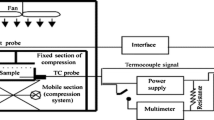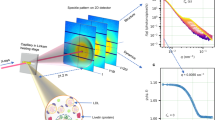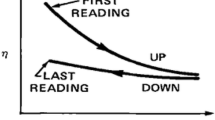Abstract
Thermally-induced transitions of egg yolk were studied using Differential Scanning Calorimetry (DSC) and temperature-controlled Small Amplitude Oscillatory Shear (SAOS). The influence of composition (pH and electrolyte content and type) was analysed. The results obtained under DSC measurements suggest a continuous evolution in protein denaturation that depends on pH and salt content. Cure experiments performed using SAOS show dramatic increases in viscoelasticity functions. Protein gelation is affected by the pH, ionic strength and salt type. SAOS was also used to obtain the mechanical spectra of egg yolk dispersions and gels as a function of composition. The microstructures of gels were also evaluated by Scanning Electron Microscopy (SEM). SEM results reveal an increase in microstructure homogeneity and a decrease in the size of aggregates at lowered pH. The influence of pH and ionic strength on linear viscoelastic properties and microstructure may be explained in terms of the model for the formation of gel networks of globular proteins. However, the characteristic structure of native yolk must also be considered.






Similar content being viewed by others
References
Anton M, Beaumal V, Gandermer G (2000) Adsorption of the oil-water interface and emulsifying properties of native granules from egg yolk: effect of aggregated state. Food Hydrocolloid 14:385–93
Anton M, Le Denmat M, Beaumal V, Pilet P (2001) Filler effects of oil droplets on the rheology of heat-set emulsion gels prepared with egg yolk and egg yolk fractions. Food Hydrocolloid 21:137–47
Anton M, Martinet V, Dalgalarrondo M, Beaumal V, David-Briand E, Rabesona H (2003) Chemical and structural characterization of low-density lipoproteins purified from hen egg yolk. Food Chem 83:175–83
Aymard P, Nicolai T, Durand D, Clark A (1999) Static and dynamic scattering of β-lactoglobulin aggregates formed after heat-induced denaturation at pH 2. Macromolecules 32:2542–2552
Boye IJ, Ma CY, Harwalkar VR (1997a) In: Damodaran S, Paraf A (eds) Food proteins and their applications. Marcel Dekker, New York, pp 25–56
Boye JI, Ma CY, Ismail A, Harwalkar VR, Kalab M (1997b) Molecular and microstructural studies of thermal denaturation and gelation of β-lactoglobulins, A and B. J Agr Food Chem 45:1608–1618
Burley RW, Cook WH (1961) Isolation and composition of avian egg yolk granules and their constituents alpha- and beta-lipovitelins. Can J Biochem Phys 39:1295–1307
Causeret D, Matringe E, Lorient D (1991) Ionic strength and pH effects on composition and microstructure of yolk granules. J Food Sci 56:1532–1536
Clark AH (1998) In: Hill SE, Ledward DA, Mitchell JR (eds) Functional properties of food macromolecules. Aspen, Gaithersburg, MD, pp 77–142
Clark AH, Kavanagh GM, Ross-Murphy SB (2001) Globular protein gelation-theory and experiment. Food Hydrocolloid 15:383–400
Cordobes F, Partal P, Guerrero A (2004) Rheology and microstructure of heat-induced egg yolk gels. Rheol Acta 43:184–195
Damodaran S, Kinsella JE (1982) In: Cherry JP (ed) Food protein deterioration: mechanisms and functionality. ACS Symp 206:327
Doi E (1993) Gels and gelling of globular proteins. Trends Food Sci Technol 4:1–5
Fernández-Martín F, Fernández P, Carballo J, Jiménez Colmenero F (1997) Pressure/heat combinations on pork meat batters: protein thermal behavior and product rheological properties. J Agr Food Chem 45:4440–4445
Foegeding EA, Davis JP, Doucet D, McGuffey MK (2001) Advances in modifying and understanding whey protein functionality. Trends Food Sci Technol 13:151–159
Gosal WS, Ross-Murphy SB (2000) Globular protein gelation. Curr Opin Colloid Interf Sci 5:209–215
Handa A; Hayashi K, Shidara H, Kuroda N (2001) Correlation of the protein structure and gelling properties in dried egg white products. J Agr Food Chem 49:3957–3964
Harrison LJ, Cunningham FE (1986) Influence of frozen storage time on properties of salted yolk and its functionality in mayonnaise. J Food Quality 9:167–174
Hegg P (1982) Conditions for the formation of heat-induced gels of some globular food proteins. J Food Sci 47:1241–1244
Kiosseoglou VD (2003) Functional properties of egg yolk. Proc Xth European Symp Quality of Eggs and Egg Products, 23–26 September 2003, Saint Brieuc, France, 3:302–311
Kiosseoglou VD, Sherman P (1983a) The influence of egg yolk lipoproteins on the rheology and stability of O/W emulsions and mayonnaise. Colloid Polym Sci 261:502–507
Kiosseoglou VD, Sherman P (1983b) The rheological conditions associated with judgment of pourability and spreadability of salad dressing. J Texture Stud 14:277–282
Koidis A, Paraskevopoulou A, Kiosseoglou V (2002) Fracture and textural properties of low fat egg yolk gels containing emulsion droplets. Food Hydrocolloid 16:673–8
Le Denmat M, Anton M, Gandemer G (1999) Protein denaturation and emulsifying properties of plasma and granules of egg yolk as related to heat treatment. J Food Sci 64:194–7
Le Denmat M, Anton M, Beaumal V (2000) Characterisation of emulsion properties and of interface composition in O/W emulsion prepared with hen egg yolk, plasma and granules. Food Hydrocolloid 14:539–549
Martin WG, Augustyniak J, Cook WH (1964) Fractionation and characterization of the low-density lipoproteins of hen’s egg yolk. Biochim Biophys Acta 84:714–720
Nishinari K, Zhang HB, Ikeda S (2000) Hydrocolloid gels of polysaccharides and proteins. Curr Opin Colloid Interf Sci 5:195–201
Oakenfull D, Pearce J, Burley RW (1997) In: Damodaran S, Paraf A (eds) Food proteins and their applications. Marcel Dekker, New York, pp 111–142
Paraskevopoulou A, Kiosseoglou V (1997) Texture profile analysis of heat-formed gels and cakes prepared with low cholesterol egg yolk concentrates. J Food Sci 62:208–11
Paraskevopoulou A, Kiosseoglou V, Alevisopoulos S, Kasapis S (2000) Small deformation measurements of single and mixed gels of low cholesterol yolk and egg white. J Texture Stud 31:225–44
Puppo MC, Añon MC (1998) Structural properties of heat-induced soy protein gels as affected by ionic strength and pH. J Agr Food Chem 46:3583–3589
Puppo MC, Añon MC (1999a) Soybean protein dispersions at acid pH: thermal and rheological properties. J Food Sci 64:50–56
Puppo MC, Añon MC (1999b) Rheological properties of acidic soybean protein gels: salt addition effect. Food Hydrocolloid 13:167–176
Rodd AB, Dunstan DE, Ross-Murphy SB, Boger DV (2001) Dependence of linear viscoelastic critical strain and stress values on extent of gelation for a thermally activated gelling system. Rheol Acta 40:23–29
Sánchez C, Burgos J (1997) Gelation of sunflower globulin hydrolysates: rheological and calorimetric studies. J Agr Food Chem 45:2407–2412
Shenstone FS (1968) In: Carter TC (ed) Egg quality: a study of the hen’s egg. Oliver and Boyd, Edinburgh, pp 26–66
Standing M, Langton M, Hermansson AM (1995) Small and large deformation studies of protein gels. J Rheol 39:1445–1450
Vardhanabhuti B, Foegeding EA, McGuffey MK, Daubert CR, Swaisgood HE (2001) Gelation properties of dispersions containing polymerized and native whey protein isolate. Food Hydrocolloid 15:165–175
Verheul M, Roefs SPFM (1998) Structure of particulate whey protein gels: Effect of NaCl concentration, pH, heating temperature, and protein composition. J Agr Food Chem 46:4909–4916
Acknowledgements
This work is part of a research project sponsored by the CICYT (ALI 99–0502) and the MCYT-FEDER programme (AGL2002–01106). The authors gratefully acknowledge its financial support.
Author information
Authors and Affiliations
Corresponding author
Rights and permissions
About this article
Cite this article
Guerrero, A., Carmona, J.A., Martínez, I. et al. Effect of pH and added electrolyte on the thermal-induced transitions of egg yolk. Rheol Acta 43, 539–549 (2004). https://doi.org/10.1007/s00397-004-0395-2
Received:
Accepted:
Published:
Issue Date:
DOI: https://doi.org/10.1007/s00397-004-0395-2




